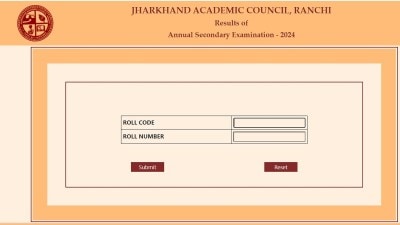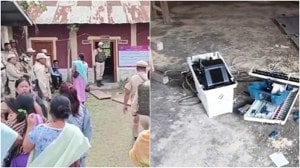- India
- International
Gadchiroli attack: ‘Trees red with blood. Body parts everywhere, even hanging from branches’
When The Indian Express visited the site on Thursday, the wrecked vehicle lay strewn on the road, its front bumper and rear wheels having come apart, and the surrounding vegetation scorched black.
 Officials at the blast site in Gadchiroli on Thursday. (Express photo)
Officials at the blast site in Gadchiroli on Thursday. (Express photo)
At A tea shop on Korchi Road near Jambhur Kheda village in Gadchiroli, about 6 km from the spot where 15 security personnel and their driver were killed in a landmine blast triggered by Naxals, an off-duty policeman struggled to relive the horror. He just could not get the sight of his colleagues lying dead on the road out of his head.
“The trees were red with blood. There were body parts everywhere, even hanging from the branches,” he said. The policeman, who did not wished to be named, claimed to have been one of the dozen first responders when an Improvised Explosive Device (IED), using a command wire system, detonated between 11.30 am and 12 pm near Jambhur Kheda village.
Fifteen Quick Response Team (QRT) personnel and an civilian, the driver of the Tata Ace car in which they were travelling, died on the spot.
Editorial | The Maoist challenge
On Thursday, the site of the explosion was cordoned off, as the police recovered the remnants of the deceased and forensic and bomb disposal experts swept the area for clues. Motorists were directed to take an alternate road while armoured personnel vehicles were parked at intervals of several metres on the stretch.
Maharashtra DGP Subodh Kumar Jaiswal confirmed that the IED had been placed in a culvert on the tarred road. “From the way the explosive was blown and the distance travelled by the debris, it is very clear that a substantive amount of explosives was used. We have sent samples to the forensic science laboratory. Only after its report is received will we know the make and quantity of the explosives,” he said.

Commandos at the spot estimated, after finding vehicle parts flung more than 400 metres away, that 30-40 kg of explosives had been detonated.
The explosion left a massive crater on the road. “The Naxals must have dug up the road and placed the explosive recently,” said Rambhau Lanjewar, a resident of Kurkheda village. Lanjewar, who was also among the first to reach the blast site, said that he first assumed that a tourist car had exploded. “Only after looking at the uniforms closely did it become clear that policemen had died,” he added.
When The Indian Express visited the site on Thursday, the wrecked vehicle lay strewn on the road, its front bumper and rear wheels having come apart, and the surrounding vegetation scorched black.
The police said that the 15 QRT personnel had left from Kurkheda police station at 11.23 am on Wednesday in a private vehicle and were to report to Purada police station, where Kurkheda Sub-Divisional Police Officer (SDPO) Shailesh Kale had summoned them, to investigate the torching of 36 vehicles of a road construction crew in the nearby Dadapur village.
The chain of events leading to the blast is under assessment, said Jaiswal. He conceded, however, that errors had been made. “There could have been some errors in our appreciation and understanding. We are studying what went wrong in our standard operating procedures (SOP)and whether they need to be changed,” he added.
While Jaiswal did not comment on the precautions taken before the QRT had begun its journey, local residents said that the road had been assumed safe as SDPO Kale had passed through it only hours earlier.
Citing the findings of a preliminary probe, an officer at the Purada police station suggested that two men on a motorbike riding some distance ahead of the minivan communicated to a third operative near the site to detonate the explosive.
“There has been a massive intelligence failure. How else would the Naxals know exactly which car to target, who was travelling and at what time?” asked Mayur Shinde, a friend of the deceased driver, Tomeshwar Singhnath.
At Dadapur, 20 km away from the blast site, and where the trouble began, the smoke is yet to settle. An acrid stench of burnt rubber lingers around the 36 vehicles, which the police claimed were set ablaze by Naxals early Wednesday.
Work on a stretch of a highway in Dadapur, connecting Purada, is being carried out by a Chhattisgarh-based civil contractor, who has leased the village’s ground, where bullock races are held, to set up a makeshift cement mixing plant.
Villagers said that around 1 am on Wednesday, when most of the crew was asleep, a group of 50 to 60 armed men surrounded the work area. “The Naxals rounded up the men, took away their phones and laid them in a pile. Then they poured diesel over the trucks, cement mixers and cabins,” said a villager.
The Naxals, said the villagers, were speaking in Hindi, Marathi and Gond, and took the care of not setting fire to a diesel tanker. “Had the tanker caught fire, the whole village would have been up in flames. The attackers parked it a safe distance away,” added the villager.
Residents claimed that the Naxals left two hours later, handing the crew back their phones, and hanging over two dozen banners across the village, warning the road contractors and the state government against carrying out further construction work.
With no sign of the crew for over 24 hours and with work at a standstill, everything in the village, including the banners, lies untouched. The only sign of life on Thursday morning was a wedding in progress in one of 50 homes that make up the hamlet. “There has been no sign of the police so far. They have to remove these banners. We will not touch them,” said the villager.
The DGP said that operations against the Naxals would continue. “We will not stop our operations. We will continue with full force at our command. This shall not pass. Our morale will not go down,” he added.
A senior state police officer said that usually, when vehicles are set on fire by Naxals, they also place landmines along the route, knowing that a police team will be headed to the spot. “Aware of this strategy, in cases of arson, we would wait for a few days before going to the spot to ensure that we do not end up falling victim to a landmine,” the officer added.
The officer said that a probe will be conducted to find out why SOPs like using an armoured vehicle or a road opening party (ROP) was not followed by the QRT. “At times, to ensure that there is an element of surprise and that Naxals are not aware about their movement, police teams are known to use various measures, like traveling in trucks and state transport buses. I do not know if this is why a ROP was not used this time. However, these aspects will be inquired into.”
Apr 19: Latest News
- 01
- 02
- 03
- 04
- 05






































